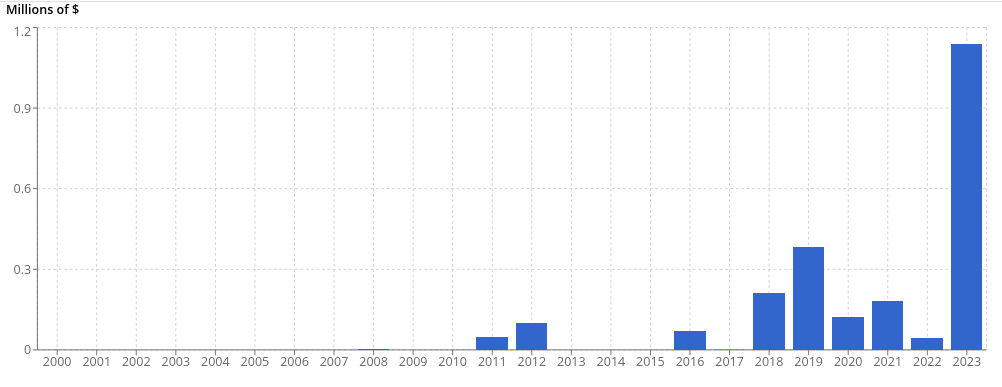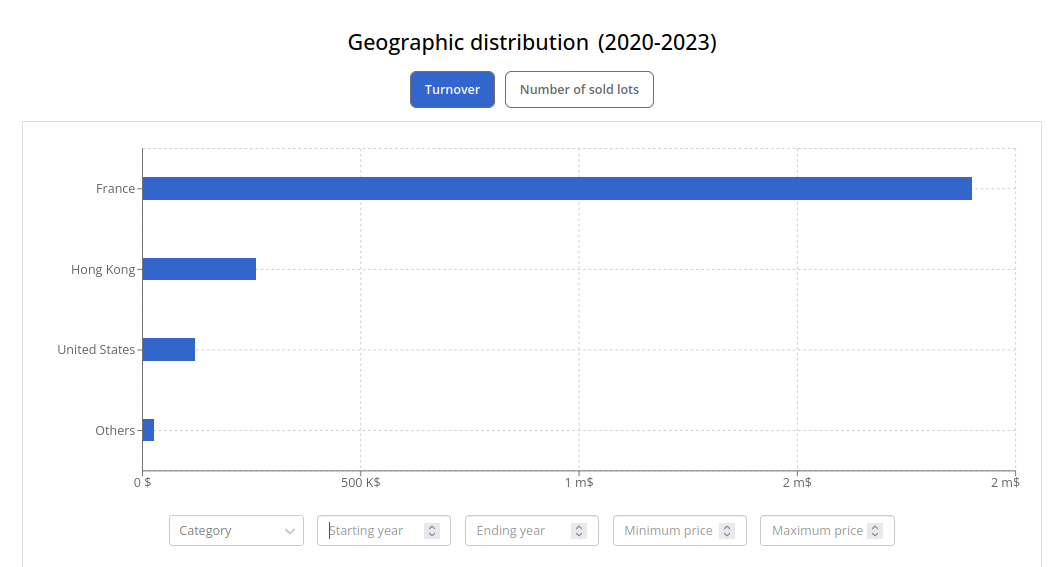Fabienne Verdier’s spiritual-truth-seeking œuvre has found its way in the art market
[29.12.2023]Veritable breaths of fresh air in today’s creative universe, Fabienne Verdier’s almost minimalist works are being revalued on the auction market.
At the beginning of 2023, Fabienne Verdier enjoyed a major exhibition of her work that was mounted in dialogue with the superb collection of Old and Modern masters in Colmar’s Unterlinden Museum. The exhibition presented a large number of new paintings inspired by her exchanges with her astrophysicist friend Trinh Xuan Thuan. Under the title Le Chant des étoiles (The Songs of the Stars), the exhibition gave birth to her series Rainbow-paintings, inspired by the chromatic palette that Grünewald used to depict the Resurrection on the back of the famous Isenheim altarpiece, a work that celebrates light and energy waves.
By allowing herself to be inspired by great artists and the major astrophysical forces that shape our universe, Fabienne VERDIER contributes to the perpetual mutation of forms. Her work appears to continue the pictorial and philosophical dialogue initiated by Chinese artist Zao Wou Ki, the first artist to achieve a true symbiosis between China and the West. Having absorbed the essence of Chinese calligraphy in her younger years, Fabienne Verdier steers this artform into other paths, with new techniques and a positively contemporary spirit.
Fabienne Verdier’s annual turnover at auction (copyright Artprice.com)

A ten years quest for the sources of calligraphy
Fabienne Verdier expressed her desire to become a painter at a very early age, but against the wishes of her parents. They tried to discourage her, but the young woman had already demonstrated solid motivation coupled with a highly disciplined nature that would ultimately make her journey an extraordinary one. After shining as a brilliant student at the Toulouse School of Fine Arts, she went through a period of profound self-questioning to the point that she refused to continue her studies in Paris. Against the backdrop of the constant need for innovation that animated the 1980s, Verdier was about to abandon art altogether when the city of Toulouse signed a twin-town agreement with Chongqing, in Sichuan. Fabienne Verdier asked to be sent there with the aim of being introduced to Chinese pictorial and calligraphic art. It was 1983 when she became the first Western student accepted into communist China. However, she did not find what she was looking for in official Chinese education where Socialist Realism and its formatted painting dominated. The cultural revolution destroyed what it could of ancestral Chinese traditions, even cutting off the hands of calligraphers.
The young painter did not give up, however, and as soon as she began to master Mandarin and Sichuanese she began looking for a teacher who matched her aspirations. The last practitioners of China’s millennial calligraphic traditions were very elderly Chinese, reluctant to welcome a young Western woman into their workshops. Deprived of his hands by the revolutionaries, the first Master she met directed her towards another who initially refused categorically to transmit his knowledge. Fabienne Verdier’s persistence finally conquered the heart of Master Huang Yuan, who took her under his wing.
The teachings of Master Huang Yuan involved a long period of asceticism for the young painter. For ten years, he forced her to work on the different nuances of black and the exact copying of nomenclatures and texts in order to understand the techniques, but also the spirit of the Ancients. Calligraphy is a philosophy nourished by a Taoist relationship with the world: it aims at the line of truth where gesture and matter merge in the unity of the living being. It is a long and rigorous initiation which completely changes one’s outlook on things.
Back in France, Fabienne Verdier found a path to her own form of abstraction that without remaining in the Chinese tradition, retains the quest for essential truths and simplicity, for elegance and a sense of the sacred. She decided to adopt modern tools, working on linen canvases, using color with Titian greens and Piero della Francesca blues and she constructed gigantic horsehair brushes which give her paintings an exceptional vigor and dynamism. To make this heavy tool easier to handle once saturated with paint, the artist grafted the handlebars of her bicycle onto it. Above a canvas placed on the ground, she fluidly controls the giant brush guided by the energy of her entire body set in motion. It is like a dance above the canvas that transforms her movements into abstract shapes, both simple and yet complex.
Fabienne Verdier’s Global Ranking at auction

An œuvre that is at last being recognised on the international auction market
Entirely absorbed by the rigors of her creative activities, Fabienne Verdier has focused little attention on art market emergence strategies. At the beginning of the 2000s, she was supported by the Alice Pauli and Jaeger Bucher galleries, but her works remained confidential, and were completely absent from the auction sphere. However, several French museums, including the Cernuschi Museum and the Pompidou Center became interested and acquired some of her works for their permanent collections in 2003 and 2007 respectively.
Today, Fabienne Verdier is still only marginally present in auction sales outside France, but this could change because her work is starting to gain international recognition: In 2018 Sotheby’s in Hong Kong managed to sell one of her paintings above the $100,000 threshold and for the artist’s very first appearance in an American sale, her painting Cercie – Ascese (from Silencieuse Coincidence) fetched $151,200 on 15 March this year (at Leslie Hindman in Chicago).
Geography of Verdier’s turnover at auction (copyright Artprice.com)

In addition, the French market has, this year, hammered a new auction record for Fabienne Verdier at $431,200 for a painting entitled Ascèse (2006). This summit marks an important milestone because, in addition to doubling her previous record, it raises her to ninth place among the most successful French Contemporary artists (born after 1945 according to the Artprice classification) at auction (in terms of annual auction turnover).
French Contemporary artists are usually less expensive than their American, English or Chinese counterparts, and Fabienne Verdier is one of the rare French artists whose works fetch more than $100,000. Her popularity has built up over time, far from the speculative desires of the market, thanks to the involvement of galleries which now distribute her work in six different countries: the Custot gallery promotes her work in London and Dubai, the Lelong gallery in Paris and New York, the Alice Pauli gallery in Lausanne and the Derom gallery in Brussels. This international network appears to be essential for building a solid price standing. Here again, patience seems to be the key.




 0
0
